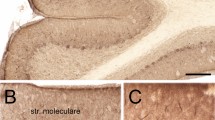Summary
The Purkinje cells of the Syrian hamster cerebellum contain dense filaments 75 Å in diameter and of relatively great hut undetermined length. These filaments occur in closely packed bundles that curve and twist through the perikaryal cytoplasm. They are always closely associated with mitochondria, never with the Golgi apparatus. Absence of previous descriptions of similar neuronal filaments indicates that they may be a unique feature in the hamster cerebellum.
Similar content being viewed by others
References
Bodian, D., and N. Taylor: Synapse arising at central node of Ranvier and note on fixation of the central nervous system. Science 139, 330–332 (1963).
Dahl, H.: Fine structure of cilia in rat cerebral cortex. Z. Zellforsch. 60, 367–386 (1963).
Grillo, M. A., and S. L. Palay: Ciliated Schwann cells in the autonomic nervous system of the adult rat. J. Cell Biol. 16, 430–436 (1963).
Luft, J. A.: Improvements in epoxy resin embedding methods. J. Cell Biol. 9, 409–414 (1961).
Morales, R., and D. Duncan: Multilaminated bodies and other unusual configurations of endoplasmic reticulum in the cerebellum of the cat. An electron microscopic study. J. Ultrastruct. Res. 15, 480–489 (1966).
—, and R. Rehmet: A distinctive laminated cytoplasmic body in the lateral geniculate body neurons of the cat. J. Ultrastruct. Res. 10, 116–123 (1964).
Murray, M. R., and H. H. Benitez: Deuterium oxide: Direct action on sympathetic ganglia isolated in culture. Science 155, 1021–1024 (1967).
Reynolds, E. S.: The use of lead citrate at high pH as an electron-opaque stain in electron microscopy. J. Cell Biol. 17, 208–212 (1963).
Sabatini, D. D., Bensch, K., and R. J. Barrnett: Cytochemistry and electron microscopy. The preservation of cellular ultrastructure and enzymatic activity by aldehyde fixation. J. Cell Biol. 17, 19–58 (1963).
Siegesmunds, K. A., C. R. Dutta, and C. A. Fox: The ultrastructure of the intranuclear rodlet in certain nerve cells. J. Anat. (Lond.) 60, 93–97 (1964).
Author information
Authors and Affiliations
Additional information
This investigation was supported by Public Health Service Research Grant NB-00690.
Rights and permissions
About this article
Cite this article
Morales, R., Duncan, D. A special type of filament in the Purkinje cells of the Syrian hamster. Z. Zellforsch. 83, 49–52 (1967). https://doi.org/10.1007/BF00334738
Received:
Issue Date:
DOI: https://doi.org/10.1007/BF00334738




